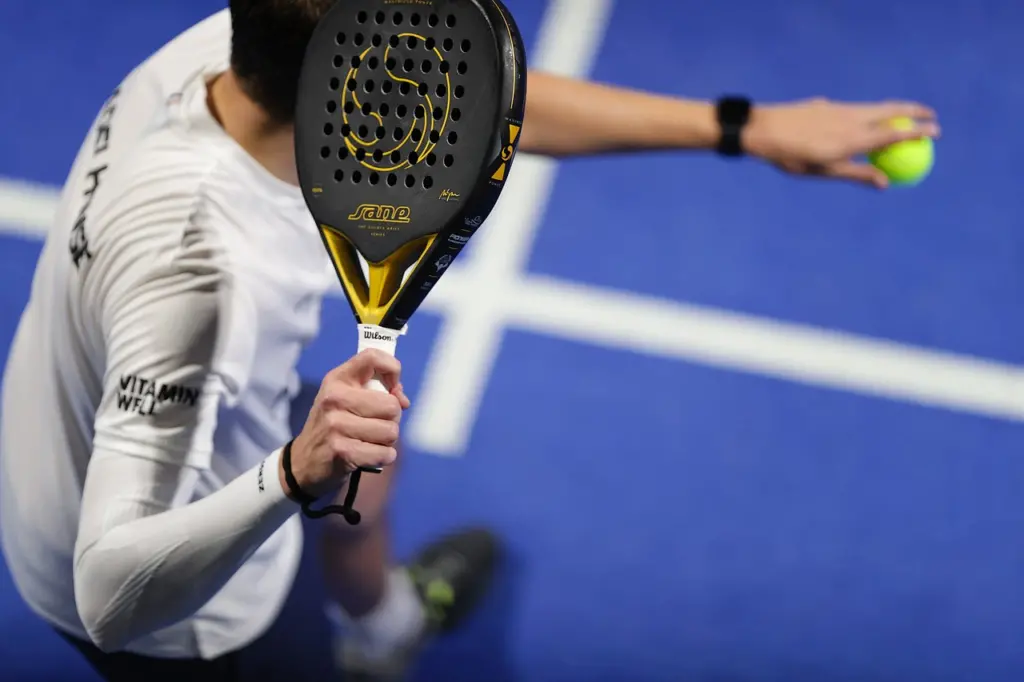- Introduction to Tennis Elbow and Massage Therapy
- The Essence of Thai Massage
- The Essence of Thai Massage
- Thai Massage for Tennis Elbow: The Techniques
- Complementary Approaches within Thai Massage Therapy
- The Holistic Benefits of Thai Massage Beyond Pain Relief
- Incorporating Swedish Massage Techniques
- Conclusion: Embracing a Holistic Path to Recovery
Introduction to Tennis Elbow and Massage Therapy
Tennis elbow, a common moniker for lateral epicondylitis, is an affliction that grips many with a sharp pang of pain, often emanating from the elbow to the forearm and wrist. Rooted in repetitive strain and overuse, this condition is not confined to the sport from which it draws its name; it can besiege anyone who engages in activities that exert excessive stress on the forearm muscles. Symptoms typically manifest as tenderness on the outside of the elbow, stiffness, and a marked weakness in grip strength. It’s in this context that massage therapy, particularly Thai massage, presents itself as a beacon of non-invasive treatment, offering succor to those beleaguered by this musculoskeletal menace.
The therapeutic touch of massage has long been revered for its capacity to assuage a spectrum of musculoskeletal conditions, fostering recovery and mitigating discomfort. As an adjunct to conventional medical treatments, massage serves not just to alleviate pain but also to enhance circulation, promote relaxation, and improve the range of motion.
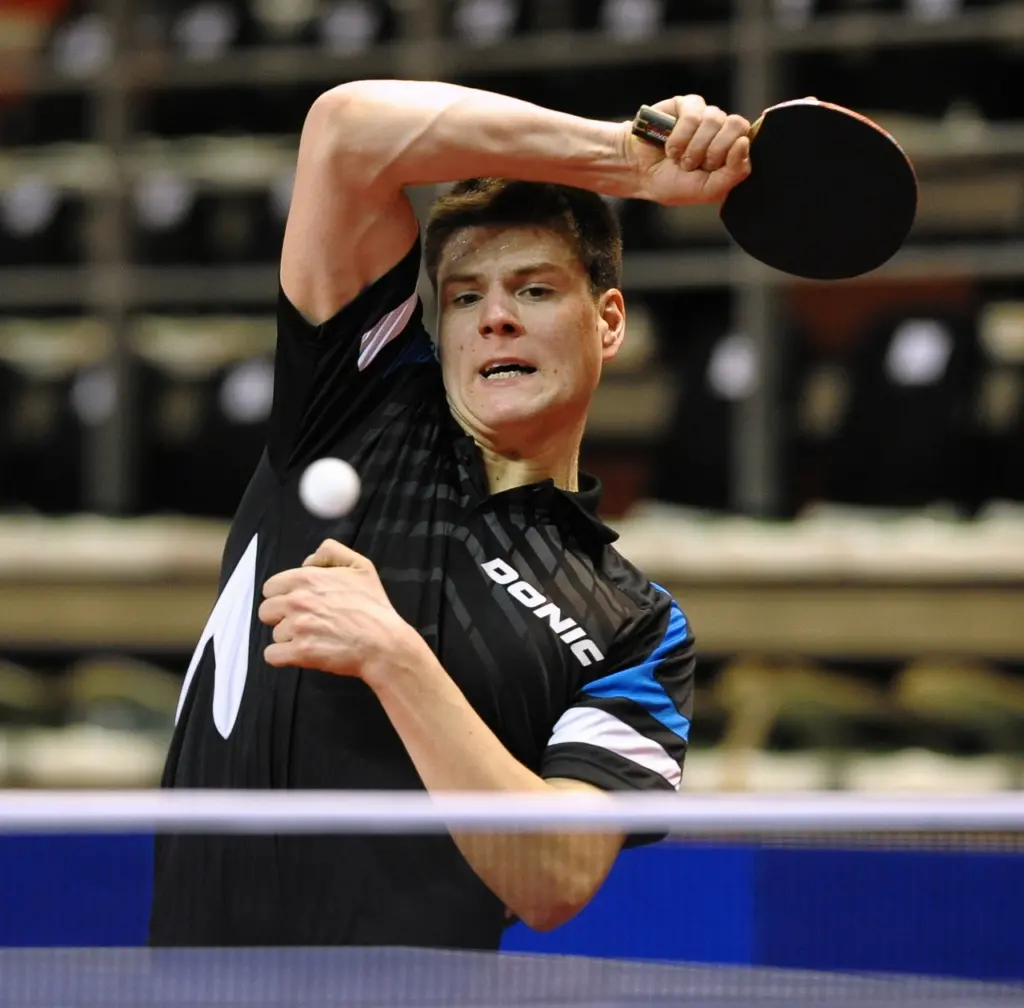
The Essence of Thai Massage
Thai massage, a venerable practice with roots steeped in the healing traditions of ancient Siam, is more than a mere physical intervention—it’s a holistic tapestry that weaves together the body’s intrinsic healing capabilities. Its principles are grounded in the belief that health and wellness are the harmonious interplay of energy flows within the body, and that restoring balance is key to alleviating malaise.
Within the rich repertoire of Thai massage techniques, each movement and manipulation is a deliberate act, orchestrated to restore equilibrium and address specific ailments. For those grappling with tennis elbow, certain techniques are particularly efficacious, offering targeted relief and fostering the body’s natural recuperative processes. In the subsequent sections, we will explore these techniques in greater detail, elucidating their unique benefits in the context of tennis elbow treatment.
The Essence of Thai Massage
Tracing its origins back to the time-honored healing traditions of ancient Thailand, Thai massage is a practice that transcends the mere kneading of muscles and sinews. It embodies a holistic approach to wellness that integrates the body, mind, and spirit. This therapeutic art form is founded on the principles of energy balance and harmonization, drawing inspiration from Ayurvedic medicine and traditional Chinese healing techniques. The essence of Thai massage lies in its ability to foster the free flow of energy, or ‘prana’, through the body’s ‘sen’ lines, equivalent to the meridians in Chinese medicine.
Thai massage is a symphony of stretching, pressure application, and rhythmic movements that invite the recipient into a state of deep relaxation while invigorating the body’s innate healing capabilities. Unlike Western massage techniques that predominantly employ oil and focus on the superficial layers of muscle, Thai massage is often performed on a mat on the floor, with clients fully clothed, facilitating a range of motion that is both therapeutic and restorative.
Differentiating Thai Massage Techniques
Thai massage is rich in diversity, with a plethora of techniques that cater to varying needs and ailments. For the purpose of addressing tennis elbow, or lateral epicondylitis, specific techniques can be particularly beneficial. The focus on ‘massage for tennis elbow’ and ‘Thai massage for tennis elbow’ allows us to highlight these specialized methods:
- Palming and thumbing the sen lines: This involves gentle but firm pressure along the energy lines, which can help release blockages and improve energy flow, reducing pain and inflammation in the elbow area.
- Passive stretching: By carefully manipulating the arm and elbow, the therapist can enhance flexibility and relieve tension in the muscles and tendons affected by tennis elbow.
- Elbow pressing: A technique where the therapist uses their own elbow to apply targeted pressure to the forearm muscles, aiding in the breakdown of adhesions and the relief of muscle tightness.
Each of these techniques is performed with a mindfulness that is central to Thai massage, ensuring a treatment that is not only physically beneficial but also mentally soothing.
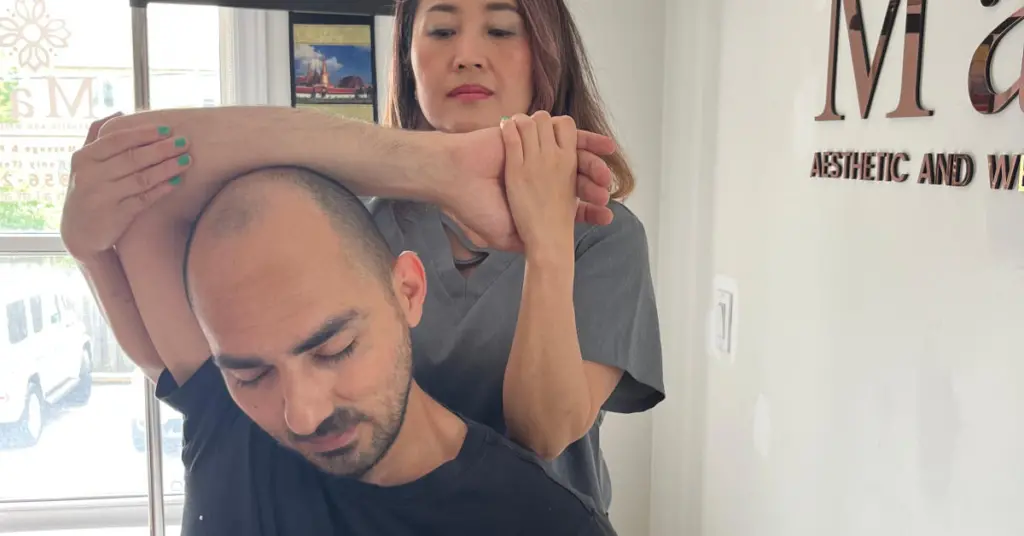
Traditional Thai Massage Methods for Elbow Pain
In the context of tennis elbow, traditional Thai massage methods are adapted to focus on the forearm and surrounding areas. The therapist may employ a combination of acupressure and stretching to enhance circulation to the affected tissues, promote the removal of toxins, and encourage healing. By focusing on the forearm extensors, which are often the source of discomfort in tennis elbow, the massage can help to alleviate the tension and pain associated with the condition.
The Significance of Plai Oil in Pain Treatment
Plai oil, derived from the Plai root (a relative of ginger), is a hallmark of Thai herbal medicine, renowned for its anti-inflammatory and analgesic properties. When incorporated into a Thai massage session, Plai oil can significantly amplify the pain-relieving effects of the treatment. This potent oil is often warmed and applied to the skin, where it penetrates deeply to soothe sore muscles and joints, making it an invaluable ally in the battle against tennis elbow.
Specialized Techniques: Thai Barefoot Massage for Tennis Elbow
Thai barefoot massage, an advanced technique where the therapist skillfully uses their feet to deliver pressure, offers a unique approach to treating tennis elbow. The therapist’s ability to modulate pressure with their feet allows for a deeper and more encompassing massage experience. This method can be particularly effective in addressing the broad muscle groups of the back and shoulders that, when tense, may contribute to the strain experienced in the elbow and forearm.
By integrating these time-honored Thai massage techniques, therapists can offer a comprehensive treatment that not only targets the symptoms of tennis elbow but also promotes an overall sense of well-being. As we continue to explore the multifaceted benefits of Thai massage, it becomes clear that this ancient practice holds a wealth of therapeutic potential for those suffering from musculoskeletal conditions like tennis elbow.
Thai Massage for Tennis Elbow: The Techniques
Tennis elbow, an ailment that can significantly hinder one’s daily activities, finds a potential respite in the ancient art of Thai massage. The traditional Thai massage methods extend beyond simple relaxation, offering therapeutic techniques that target the pain and discomfort associated with tennis elbow. Let’s delve into the specific techniques that make Thai massage an effective remedy for those suffering from this condition.
Traditional Thai Massage Methods for Elbow Pain
Traditional Thai massage for tennis elbow is a nuanced practice that focuses on the harmonization of the body’s energy lines, or sen lines, which, when blocked, can lead to pain and dysfunction. By employing a combination of acupressure, stretching, and manipulation, therapists can improve energy flow and circulation to the affected area, thus aiding in the healing process. Here’s how these methods unfold:
- Acupressure: Applying pressure to specific points along the sen lines can release tension and increase blood flow, which is vital for healing tennis elbow.
- Stretching: Gentle stretches are used to extend the muscles and tendons of the forearm, reducing stiffness and improving flexibility.
- Joint mobilization: Careful movements of the elbow joint can help restore mobility and alleviate pain.
These methods are not only designed to target the physical symptoms of tennis elbow but also to promote a sense of overall well-being, crucial for holistic healing.
The Significance of Plai Oil in Pain Treatment
Incorporating Plai Oil into a Thai massage session for tennis elbow can significantly enhance the therapeutic effects. This traditional Thai remedy is celebrated for its anti-inflammatory and analgesic properties, which can be particularly beneficial for those suffering from musculoskeletal pain. When massaged into the skin, the oil’s warming sensation provides immediate relief, while its deep-penetrating properties work to soothe inflamed tendons and muscles over time. The use of Plai Oil is a testament to the rich herbal heritage that Thai massage draws upon, offering a natural and effective means to combat pain.
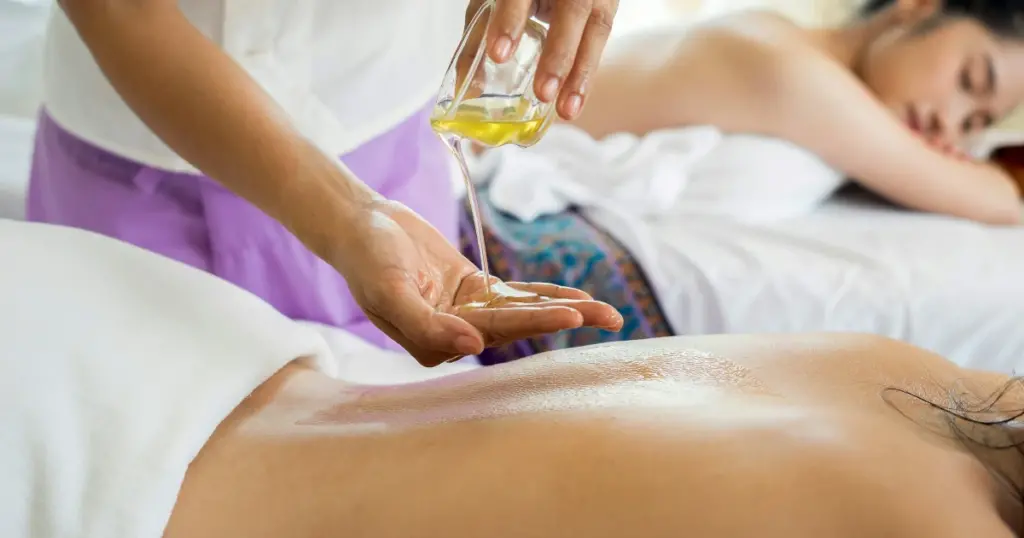
Specialized Techniques: Thai Barefoot Massage for Tennis Elbow
Thai barefoot massage, also known as “Yam Khang,” is a technique where the therapist uses their feet to apply pressure and deliver massage strokes. This method allows for a broader and more profound pressure, which can be particularly effective for addressing larger muscle groups that contribute to tennis elbow pain. Here’s how Thai barefoot massage can benefit those with tennis elbow:
- Deep tissue manipulation: The therapist’s feet can cover a larger area and provide more intense pressure, reaching deeper layers of muscle tissue.
- Enhanced precision: Despite the broader pressure, skilled therapists can target specific areas with remarkable accuracy, offering relief exactly where it’s needed.
- Increased therapeutic warmth: The use of the therapist’s feet can generate a comforting heat that aids in muscle relaxation and pain relief.
By integrating these specialized Thai massage techniques, therapists can offer a comprehensive and effective treatment for tennis elbow, addressing not only the localized pain but also contributing factors such as muscle tension and restricted movement. This section of the article aims to inform readers about the various techniques used in Thai massage for tennis elbow, emphasizing the holistic and targeted approach of this ancient healing practice.
Complementary Approaches within Thai Massage Therapy
While Thai massage alone offers a robust approach for the treatment of tennis elbow, integrating complementary techniques can enhance the healing experience. These additional methods address not only the localized pain of tennis elbow but also the interconnected factors contributing to the condition. This section explores how Thai massage for tennis elbow can be augmented with other therapeutic practices for a more holistic treatment strategy.
Addressing Office Syndrome as a Contributing Factor
Office syndrome, characterized by neck, head, hand, and arm pain, often arises from prolonged periods of desk work and poor ergonomics. This condition can exacerbate the symptoms of tennis elbow or even be a causative factor due to repetitive strain and muscle overuse. Thai massage offers specialized techniques to combat office syndrome, which can be particularly beneficial when integrated into a treatment plan for tennis elbow:
- Focused massage on the neck and shoulders: Alleviating tension in these areas can reduce the overall stress on the arm muscles and tendons.
- Hand and wrist techniques: These can improve flexibility and circulation, potentially decreasing the strain transferred to the elbow joint.
By addressing these related areas, Thai massage not only targets the immediate concerns of tennis elbow but also promotes a more comprehensive approach to musculoskeletal health.
Integrating Facial Massage for Overall Well-being
Facial massage is another complementary technique within Thai massage therapy that can indirectly benefit individuals with tennis elbow. The relaxation elicited by facial massage may contribute to a reduction in overall body tension, which can, in turn, facilitate healing in the elbow region. The benefits of incorporating facial massage into a Thai massage session include:
- Promotion of relaxation: A relaxed state can decrease muscle tension throughout the body, including the arms.
- Stimulation of parasympathetic nervous system: This can enhance the body’s natural healing processes, aiding in recovery from tennis elbow.
By integrating facial massage, therapists can offer a multifaceted treatment that not only focuses on the physical aspects of tennis elbow but also emphasizes the importance of relaxation and stress reduction as part of the healing journey.
Incorporating these complementary approaches within Thai massage therapy for tennis elbow ensures that clients receive a well-rounded and deeply therapeutic experience. It is this holistic perspective that sets Thai massage apart, offering a pathway to not just symptom relief but to overall health and well-being.
The Holistic Benefits of Thai Massage Beyond Pain Relief
The journey of healing from tennis elbow via Thai massage is not only about mitigating pain but also about embracing the holistic benefits that this ancient form of therapy offers. Thai massage transcends the boundaries of conventional massage by integrating a variety of techniques that promote overall well-being, relaxation, and a profound mind-body connection. In this section, we explore the broader spectrum of advantages that Thai massage provides, which extend far beyond the immediate relief from tennis elbow symptoms.
Enhancing Relaxation and Reducing Stress
One of the most significant benefits of Thai massage is its ability to induce deep relaxation and reduce stress. The gentle and rhythmic pressure applied during a session helps to calm the nervous system, leading to a reduction in stress hormones like cortisol. This state of relaxation is not merely a fleeting moment of tranquility but a comprehensive response that can have lasting effects on the body’s ability to heal and maintain balance. Here’s how Thai massage can enhance relaxation:
- Mindful breathing: Encouraging deep and mindful breathing during the massage can increase oxygen flow and further promote a state of calm.
- Meditative state: The intentional and flowing movements of the therapist can help clients enter a meditative state, where the mind is at ease and the body can focus on healing.
By reducing stress and enhancing relaxation, Thai massage can contribute to a more effective healing process for tennis elbow, as a relaxed body is more conducive to recovery.
The Mind-Body Connection in Healing
Thai massage is predicated on the understanding that physical ailments are often intertwined with emotional and mental states. The practice acknowledges the mind-body connection as a critical factor in the healing process. Through the integration of meditative practices, energy work, and physical manipulation, Thai massage can help to align the mental and emotional aspects of the self, thereby supporting the body’s natural healing mechanisms. Here are some ways in which Thai massage fosters this connection:
- Energy work: By focusing on the flow of energy, or ‘prana’, Thai massage can help to clear blockages and restore balance within the body’s energy system.
- Presence and awareness: The therapist’s focused attention and the client’s awareness of their body during the massage can lead to a heightened sense of presence, which is conducive to healing.
The mind-body connection is a cornerstone of holistic health, and by addressing both the physical and emotional aspects of tennis elbow, Thai massage offers a comprehensive approach to recovery.
Incorporating Swedish Massage Techniques
While Thai massage offers a holistic and targeted approach to managing tennis elbow, incorporating Swedish massage techniques can complement and enhance the overall therapeutic experience. Swedish massage, known for its gentle and flowing strokes, can provide a different spectrum of benefits that align perfectly with the principles of Thai massage. In this section, we will discuss how integrating Swedish massage techniques can provide a well-rounded approach to the treatment of tennis elbow.
Swedish massage is characterized by five main techniques: effleurage (gliding), petrissage (kneading), tapotement (rhythmic tapping), friction, and vibration/shaking. Each of these techniques has specific benefits that can be advantageous for individuals experiencing tennis elbow:
- Effleurage: This technique involves long, smooth strokes that glide over the body. It is used to warm up the muscle tissue, improve blood circulation, and promote relaxation, which can be particularly soothing for the tight muscles and tendons affected by tennis elbow.
- Petrissage: Kneading the muscles helps to release tension and knots within the muscle fibers. For tennis elbow, petrissage can be applied to the forearm and upper arm to alleviate tightness and enhance muscle function.
- Tapotement: The rhythmic tapping or percussive movements can stimulate the muscles and nerves, increase local blood flow, and invigorate the area around the elbow, which may contribute to a faster healing process.
- Friction: Using targeted pressure and small circular movements, friction can help break down scar tissue and adhesions in the tendons and muscles of the forearm, which are often present in cases of tennis elbow.
- Vibration/Shaking: These movements can help relax the muscles and induce a calming effect on the nervous system, which is beneficial for pain management and stress reduction.
Integrating these Swedish massage techniques with Thai massage offers a comprehensive treatment plan that addresses various aspects of tennis elbow:
- Muscle Warmth and Relaxation: Combining the warming effleurage strokes of Swedish massage with the stretching and pressure of Thai massage can prepare the muscles for deeper work and enhance relaxation.
- Increased Circulation: Both modalities promote improved blood flow, which is essential for delivering nutrients to the affected area and removing waste products that can contribute to inflammation and pain.
- Flexibility and Range of Motion: The passive stretching in Thai massage, coupled with the kneading of Swedish massage, can improve flexibility and range of motion in the elbow joint and surrounding muscles.
- Holistic Healing: The combination of techniques from both massage styles ensures a holistic approach to healing, addressing not only the physical symptoms but also promoting mental and emotional well-being.
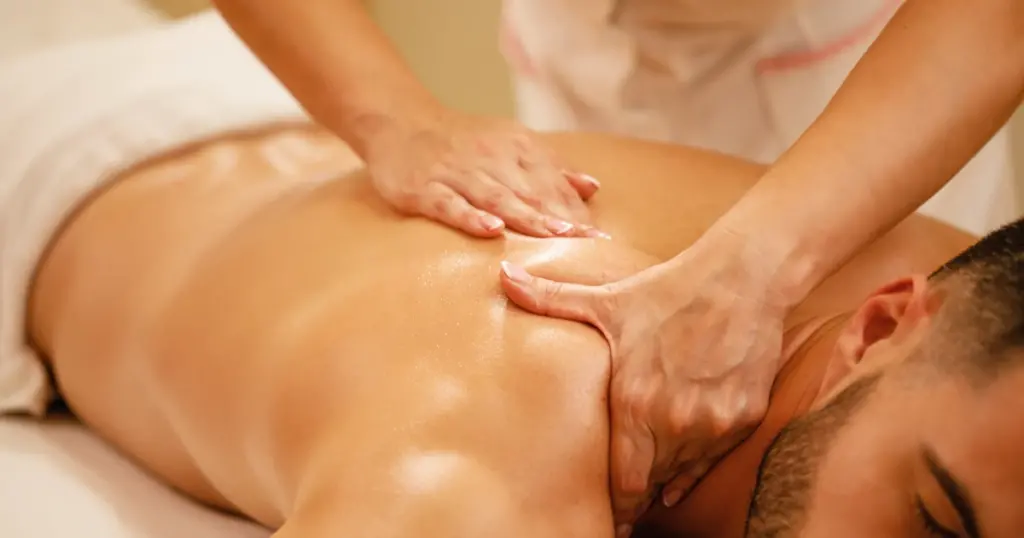
Conclusion: Embracing a Holistic Path to Recovery
As we draw this discussion to a close, it’s essential to recapitulate the holistic benefits of Thai massage for the relief of tennis elbow, a condition that can severely impact the quality of life. Through the detailed exploration of Thai massage techniques, their origins, and complementary approaches, we’ve unearthed a treasure trove of healing practices that extend well beyond mere pain alleviation.
Thai massage, with its intricate tapestry of stretches, acupressure, and energy work, offers a profound healing experience that addresses the multifaceted nature of tennis elbow. By targeting the physical manifestations of the condition and acknowledging the interconnectedness of the body’s systems, Thai massage fosters an environment conducive to recovery and long-term well-being.
The incorporation of Plai Oil, known for its soothing properties, and the specialized technique of Thai barefoot massage, underscores the rich tradition and innovative spirit that Thai massage embodies. These elements, woven into the fabric of the therapy, provide a textured approach to healing that is both time-honored and empirically effective.
Moreover, the integration of Swedish massage techniques adds another layer of depth to the treatment, offering a well-rounded approach that combines the best of both worlds. The gentle effleurage and invigorating petrissage of Swedish massage complement the dynamic stretches and pressure points of Thai massage, creating a comprehensive therapy that is both nurturing and restorative.
In embracing the holistic path to recovery, we must also acknowledge the role of relaxation and stress reduction, as well as the vital mind-body connection inherent in Thai massage. These aspects are not merely ancillary benefits but are central to the philosophy of Thai healing practices. They remind us that recovery is not a linear process but a journey that encompasses the whole person—body, mind, and spirit.
In conclusion, for individuals grappling with the challenges of tennis elbow, Thai massage represents a comprehensive treatment option that merits consideration. It is a modality that not only addresses the immediate discomfort but also invites a deeper exploration of health and wellness, encouraging a multi-faceted approach to healing. As we continue to seek out the best in therapeutic practices, Thai massage stands out as a profound ally in the quest for recovery and vitality.

